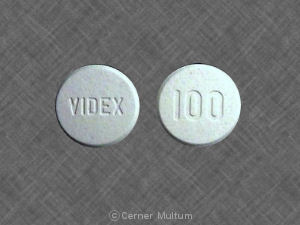Videx Dosage
Generic name: didanosine 10mg in 1mL
Dosage form: powder for oral solution
Drug class: Nucleoside reverse transcriptase inhibitors (NRTIs)
Medically reviewed by Drugs.com. Last updated on Nov 28, 2024.
VIDEX should be administered on an empty stomach, at least 30 minutes before or 2 hours after eating.
Recommended Dosage (Adult and Pediatric Patients)
The preferred dosing frequency of VIDEX is twice daily because there is more evidence to support the effectiveness of this dosing regimen. Once-daily dosing should be considered only for patients whose management requires once-daily dosing of VIDEX. The recommended adult total daily dose is based on body weight (kg) (see Table 1).
| at least 60 kg | less than 60 kg | |
|---|---|---|
|
Preferred dosing |
200 mg twice daily |
125 mg twice daily |
|
Dosing for patients whose management requires once-daily frequency |
400 mg once daily |
250 mg once daily |
Pediatric Patients (2 weeks old to 18 years old): The recommended dose of VIDEX (didanosine) in pediatric patients between 2 weeks old and 8 months old is 100 mg per m2 twice daily, and the recommended VIDEX dose for pediatric patients greater than 8 months old is 120 mg per m2 twice daily but not to exceed the adult dosing recommendation.
Dosing recommendations in patients less than 2 weeks of age cannot be made because the pharmacokinetics of didanosine in these children are too variable to determine an appropriate dose. There are no data on once-daily dosing of VIDEX in pediatric patients.
Renal Impairment
Adult Patients
In adult patients with impaired renal function, the dose of VIDEX should be adjusted to compensate for the slower rate of elimination. The recommended doses and dosing intervals of VIDEX in adult patients with renal insufficiency are presented in Table 2.
| a 400 mg once daily (at least 60 kg) or 250 mg once daily (less than 60 kg) for patients whose management requires once-daily frequency of administration. | ||
|
Creatinine Clearance |
Recommended VIDEX Dose by Patient Weight |
|
|
at least 60 kg |
less than 60 kg |
|
|
at least 60 |
200 mg twice dailya |
125 mg twice dailya |
|
30-59 |
200 mg once daily |
150 mg once daily |
|
10-29 |
150 mg once daily |
100 mg once daily |
|
less than 10 |
100 mg once daily |
75 mg once daily |
Pediatric Patients
Urinary excretion is also a major route of elimination of didanosine in pediatric patients, therefore the clearance of didanosine may be altered in pediatric patients with renal impairment. Although there are insufficient data to recommend a specific dose adjustment of VIDEX in this patient population, a reduction in the dose should be considered (see Table 2).
Patients Requiring Continuous Ambulatory Peritoneal Dialysis (CAPD) or Hemodialysis
For patients requiring CAPD or hemodialysis, follow dosing recommendations for patients with creatinine clearance of less than 10 mL per min, shown in Table 2. It is not necessary to administer a supplemental dose of VIDEX following hemodialysis.
Dosage Adjustment
Concomitant Therapy with Tenofovir Disoproxil Fumarate
In patients who are also taking tenofovir disoproxil fumarate, a dose reduction of VIDEX to 250 mg (adults weighing at least 60 kg with creatinine clearance of at least 60 mL per min) or 200 mg (adults weighing less than 60 kg with creatinine clearance of at least 60 mL per min) once daily is recommended. VIDEX and tenofovir disoproxil fumarate may be taken together in the fasted state. Alternatively, if tenofovir disoproxil fumarate is taken with food, VIDEX should be taken on an empty stomach (at least 30 minutes before food or 2 hours after food). The appropriate dose of VIDEX coadministered with tenofovir disoproxil fumarate in patients with creatinine clearance of less than 60 mL per min has not been established.; see the complete prescribing information for VIDEX EC (enteric-coated formulation of didanosine) for results of drug interaction studies of tenofovir disoproxil fumarate with reduced doses of the enteric-coated formulation of didanosine.)
Instructions for Reconstitution
Prior to dispensing, the pharmacist must reconstitute dry powder with Purified Water, USP, to an initial concentration
of 20 mg per mL and immediately mix the resulting solution with antacid to a final concentration of 10 mg per mL as
follows:
20 mg per mL Initial Solution
Reconstitute the product to 20 mg per mL by adding 100 mL or 200 mL of Purified Water, USP, to the 2 g or 4 g of
VIDEX powder, respectively, in the product bottle.
10 mg per mL Final Admixture
- Immediately mix one part of the 20 mg per mL initial solution with one part of any commercially available antacid that contains as active ingredients aluminum hydroxide (400 mg per 5 mL), magnesium hydroxide (400 mg per 5 mL), and simethicone (40 mg per 5 mL) for a final dispensing concentration of 10 mg VIDEX per mL. For patient home use, the admixture should be dispensed in appropriately sized, flint-glass or plastic (HDPE, PET, or PETG) bottles with child-resistant closures.
- Instruct the patient to shake the admixture thoroughly prior to use and to store the tightly closed container in the
refrigerator.
The bottles of powder should be stored at 59 °F to 86 °F (15 °C to 30 °C). The VIDEX admixture may be stored up to
30 days in a refrigerator, 36 °F to 46 °F (2 °C to 8 °C). Discard any unused portion after 30 days.
More about Videx (didanosine)
- Check interactions
- Compare alternatives
- Drug images
- Side effects
- During pregnancy
- Drug class: nucleoside reverse transcriptase inhibitors (NRTIs)
- Breastfeeding
Patient resources
Other brands
Professional resources
Other brands
Related treatment guides
See also:
Further information
Always consult your healthcare provider to ensure the information displayed on this page applies to your personal circumstances.


